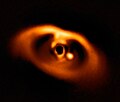Eyeball planet
An eyeball planet[1] is a hypothetical type of tidally locked planet, for which tidal locking induces spatial features (for example in the geography or composition of the planet) resembling an eyeball.[2] They are terrestrial planets where liquids may be present, in which tidal locking will induce a spatially dependent temperature gradient (the planet will be hotter on the side facing the star and colder on the other side). This temperature gradient may therefore limit the places in which liquid may exist on the surface of the planet to ring- or disk-shaped areas.
Such planets are further divided into "hot" and "cold" types, depending on which side of the planet the liquid is present. A "hot" eyeball planet is usually closer to its host star, and the centre of the "eye", facing the star (day side), is made of rock while liquid is present on the opposite side (night side). A "cold" eyeball planet, usually farther from the star, will have liquid on the side facing the host star while the rest of its surface is made of ice and rocks.[3][4][5]
Because most planetary bodies have a natural tendency toward becoming tidally locked to their host body for a long enough timeline, eyeball planets may be common and could host life, particularly in planetary systems orbiting red and brown dwarf stars which have lifespans much longer than other main-sequence stars.[6]
Modeling and climate
[edit]Scientists use computer models to study how tidally locked planets—those that always show the same side to their star—might behave. These models show that the side facing the star can become extremely hot, while the side in constant darkness can get very cold. This big difference in temperature can shape how water behaves on the planet’s surface.[7]
That’s what gives an "eyeball planet" its name: a hot, dry center (like a pupil), surrounded by a ring of possible water or ice (like the iris).[7] If the planet has even a thin atmosphere or ocean, heat can spread from the hot side to the cold side. This can create a narrow region along the edge between day and night called the terminator where temperatures are just right for liquid water to exist.[7]
Studies by climate scientists have used general circulation models (GCMs) to simulate these dynamics. These models show that factors like greenhouse gas composition, rotation rate, surface albedo, and cloud formation significantly affect where liquid water can persist.[8]
Potential candidates
[edit]Kepler-1652b is potentially an eyeball planet.[9] The TRAPPIST-1 system may contain several such planets.[10] According to the observations of the James Webb Space Telescope in 2024, the super-Earth[a] planet LHS 1140b might either have a thin ice shell with a subsurface ocean or an icy surface covered partially in liquid water, the latter of which is an attribute of "cold" eyeball planet.[11]
See also
[edit]- Linear settlement – a type of settlement that could be set up on such planets
- Tidal locking
- Extraterrestrial liquid water
- Surface features of exoplanet
- Terrestrial planet
References
[edit]- ^ Pierrehumbert, Raymond; Gaidos, Eric (19 May 2011). "Hydrogen Greenhouse Planets Beyond the Habitable Zone". The Astrophysical Journal. 734 (1): L13. arXiv:1105.0021. Bibcode:2011ApJ...734L..13P. doi:10.1088/2041-8205/734/1/l13. ISSN 2041-8205.
- ^ Starr, Michelle (5 January 2020). "Eyeball Planets Might Exist, And They're as Creepy as They Sound". ScienceAlert.com. Retrieved 6 January 2020.
- ^ Pierrehumbert, Raymond; Gaidos, Eric (2011). "Hydrogen Greenhouse Planets Beyond the Habitable Zone". The Astrophysical Journal Letters. 734 (1): L13. Bibcode:2011ApJ...734L..13P. doi:10.1088/2041-8205/734/1/L13.
- ^ Raymond, Sean (2020). "Forget Earthlike—We'll First Find Aliens on Eyeball Planets". Nautilus. Retrieved 10 May 2025.
- ^ "Water Trapped Worlds". NASA Exoplanet Exploration. Retrieved 10 May 2025.
- ^ Raymond, Sean (20 February 2015). "Forget 'Earth-Like'—We'll First Find Aliens on Eyeball Planets". Nautilus. Archived from the original on 15 December 2021. Retrieved 28 May 2022.
- ^ a b c Yang, Jun; Cowan, Nicolas B.; Abbot, Dorian S. (1 July 2013). "Stabilizing Cloud Feedback Dramatically Expands the Habitable Zone of Tidally Locked Planets". The Astrophysical Journal Letters. 771 (2): L45. arXiv:1307.0515. Bibcode:2013ApJ...771L..45Y. doi:10.1088/2041-8205/771/2/L45.
- ^ Kopparapu, Ravi Kumar; Wolf, Eric T.; Haqq-Misra, Jacob (1 March 2017). "Habitable Moist Atmospheres on Terrestrial Planets Near the Inner Edge of the Habitable Zone Around M Dwarfs". The Astrophysical Journal. 845 (1): 5. arXiv:1705.10362. Bibcode:2017ApJ...845....5K. doi:10.3847/1538-4357/aa7cf9.
- ^ Tasker, Elizabeth (7 September 2017). The Planet Factory: Exoplanets and the Search for a Second Earth. Bloomsbury Publishing. ISBN 978-1-4729-1775-1.
- ^ Anders, Charlie Jane (13 February 2019). "The Bizarre Planets That Could Be Humanity's New Homes". The Atlantic. Retrieved 10 February 2021.
- ^ "Habitable Zone Exoplanet LHS 1140b is Probably Snowball or Water World". Sci.News. 9 July 2024. Retrieved 10 July 2024.
Notes
[edit]- ^ The mass range of super-Earths is disputed.



